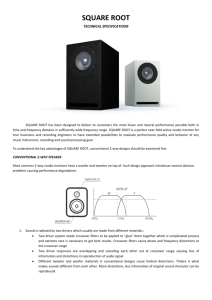Tweeter Paper Outline
advertisement
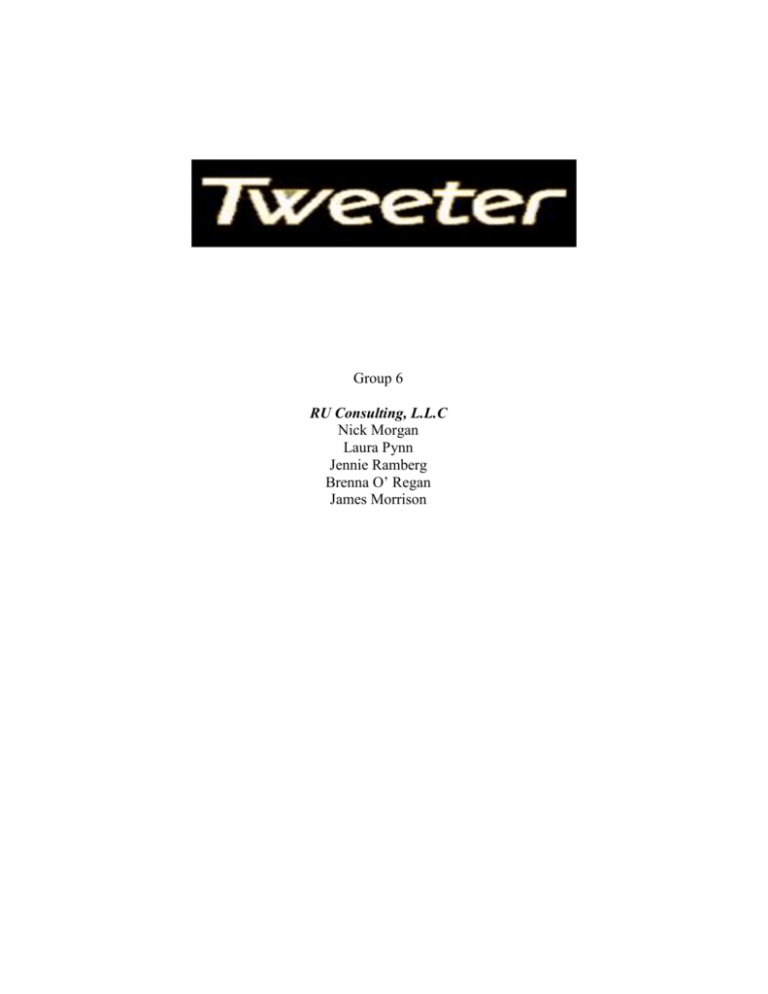
Group 6 RU Consulting, L.L.C Nick Morgan Laura Pynn Jennie Ramberg Brenna O’ Regan James Morrison Tweeter, etc. is an audio/video company that faced pricing strategy problems in 1993 that made the history books for adverse pricing strategies. Sandy Bloomberg formed the company in 1972 and the company faired well in the 1970’s and 1980’s. It grew to 13 stores when they implemented the Automatic Price Protection pricing strategy. This strategy nearly drove the company into bankruptcy. The company still faces unremitting problems which this paper will address. This is our proposal as RU Consulting, L.L.C. First, we will examine how the company evolved. Second, an analysis of the company’s strengths, weaknesses, opportunities and their threats will be considered and an analysis of their corporate strategies will be given. Third, we have included our solutions and recommendations for this company. Last, we would like to give our recommendation to you as the stockholder on what you should do with the stock you are holding. Tweeter started out as a small retailer of high-end audio/video equipment right outside of Boston University. This store was a success and soon expanded into 13 stores through out New England. 1 It began to get a reputation for its excellent service and quality products and sales soared. However, in the late 1980’s, the bottom fell out of the electronic market and caused two things: price wars with local competition; and Tweeter then joined the Progressive Retailers Organization, in 1988. This organization combined the buying power of small high-end consumer electronic retailers across the United States which allowed them to negotiate with manufacturers to obtain prices which were competitive with larger retailers. 2 In short this organization kept the retailer’s market from dropping out from under them. They did this by setting price standards up that nobody who sells certain brands and models of products can sell them below a given price at which they all agreed to. “Tweeter Home Entertainment Group, Inc- Company History” , http://www.fundinguniverse.com/comanyhistories/Tweeter-Home Entertainment-Group, retrieved 02/22/2007. 2 “Tweeter,etc”, Marketing Management, Case Analysis by Teams, Mattson, Melvin R, 2005, pg. 133. 1 In the early 1990’s, Tweeter’s sales were dropping. They conducted focus groups to figure out where the problem was. Their surveys said the customer understood that they had excellent service, but they didn’t like the high prices. So Tweeter’s management staff came up with Automatic Price Protection to combat the perception of high prices. Tweeter would monitor the weekly sales ads of all the major local papers and cross reference that with sales within 30 days; and if a customer paid more for a product than the sale price, Tweeter would refund the difference. At first, this strategy was good, but as larger competition moved in, Tweeter began writing more and larger checks. By December, 1995, Tweeter in total had written 29,526 checks to the tune of $783,863. 3 This nearly drove the company into bankruptcy and later led them to be studied as adverse pricing strategies. Tweeter began to shift its focus from APP pricing strategy to making money by acquisition of other small high-end retailers of electronics. Like the APP, this strategy worked well at first and then failed. Here is a listed breakdown of their acquisitions (listed only for historical relevance): “1996 Bryn Mawr -13stores 1997 HiFi Buys- 10 stores 1998 made their first public offering of stock, $40 a share and changed their name to Tweeter Home entertainment Group, Inc. 3 1999 Home Entertainment of Texas- 7 stores 1999 DOW Stereo/Video, Inc. – 9 stores”4 “2000 Douglas TV- 4 stores January,2001 House of Blue Concerts to rename the Lakewood Ibid. “Tweeter Home Entertainment Group, Inc- Company History” , http://www.fundinguniverse.com/comanyhistories/Tweeter-Home Entertainment-Group, retrieved 02/22/2007. 44 Amphitheatre to HiFi Buys Amphitheatre April,2001 E-Center in Camden, NJ to rename it the Tweeter Center at the Waterfront May, 2001Big Screen City- 4 stores June, 2001 Audio-Video Systems – 3 stores August, 2001 Sound Advice- 33 stores March 2002 Hillcrest High Fidelity April, 2003 Coral Sky Amphitheatre to Sound Advice Amphitheatre July, 2004 NOW! Audio Video- 6 stores”5 The purpose of listing all the acquisitions is to emphasize how the company has grown into 154 stores in 13 states6 and it is crucial to know where we have been so we know where we are going. Each of the companies that they acquired were small retailers with a reputation for high quality service and installations. This is a rapid evolution in 10 years. It changed its strategy to focus on becoming a national retailer. They were trying to become a household name through the ‘back door’ of people’s minds. In the second section of this paper, we would like to focus on the SWOT analysis and the company’s corporate strategy on how to position itself in the consumer’s mind. The company honestly has quite a few good things going for them to differentiate themselves from other competitors in the same market. For one; the vast array of custom installation services and applications that are offered are simply un-beatable. When you want to have a home theater built specifically for you in your own home Tweeter definitely has the right 5 6 “ Company Overview”, http://www.tweeter.com Retrieved 2/22/2007 Ibid. people to get the job done the proper way. The products that Tweeter offers are also a strength that they take full advantage of. Various brands that they carry such as Denon; JL Audio, and Sennheiser are not carried by any other national retail chain stores, so Tweeter basically has this small niche market all to itself. Tweeter also does a lot of communityservice type charity drives for children in the local areas surrounding the stores. The company seems to really care about children by donating money to the Make a Wish Foundation, and the Children’s Hospital. Tweeter also offers a Music Education Scholarships for a select few people who have an interest in furthering their education on the collegiate level of music. They do an excellent job giving back to the communities that give so much to them. Unfortunately; you can have an infinite amount of strong points in a company, however you cannot escape the fact that every company has to have weaknesses as well. With the introduction of the Automatic Price Protection strategy that the management came up with nearly drove the company into bankruptcy, never to return. You simply can’t oblige yourself to pay money back out to the customers, just because a bigger company is advertising the item for cheaper, especially after the consumer has already purchased the item. Overall APP was a horrible idea, and was definitely a clue that the management needed restructuring. The corporate strategy of buying up smaller chains and gaining market share by acquisition was also not a good idea. This really spread the financial part of the company really thin, and caused us to get even deeper into price wars with larger chains such as Best Buy and Circuit City. We thought that acquiring all of these smaller stores across the United States would in turn help out the problems with the market share that we are loosing to the bigger companies, but it actually hurt us. Tweeter’s opportunities include offering high-end audio components that no other national retailers offer. By continuing their focused differentiation strategy they have the opportunity to invest in areas that make them different from the bigger retailers. These differences create value for our customers and serve as our competitive advantages. These core competencies include unparalleled customer service, high-end installations, and very high-quality audio components. By consistently focusing on these factors tweeter can expand in their high-end niche. This expansion isn’t in the number of stores, but in their consumers’ perceptual maps. Concept stores that include a concierge, interactive showrooms, and the most knowledgeable sales people are a good way to do this. This is also a good technique to cultivate future audio/video enthusiasts. Some threats that loom on the horizon for Tweeter are large chain stores like Circuit City and Best Buy. If Tweeter doesn’t position their brand name and services correctly they run the risk of being out-focused or “dwarfed” by larger competitors. Circuit City recently opened “Firedog”, their home electronics installation division. Firedog is nothing more then a service that Circuit City provides that has a crew that comes out to your house and does on-site service for your home theater or personal computer whatever problems you may be having they can fix it. Another attempt to take market share from Tweeter is Best Buys’ high-end TV stores, known as “Magnolia”. In these stores they offer premium televisions with the latest technology along with a staff that is very knowledgeable about the high end audio/video systems that they sell. Price wars are always a threat to Tweeter’s small market share. We simply cannot compete with the larger retail chains mainly because we can not move as much volume as they can. Also as products mature they are no longer seen as cutting edge by Tweeter’s patrons. Keeping “old” technology could damage their image as a high-end retailer. The vast majority of our customers tend to be people who are very involved in the latest technology available and always have to have the newest and best thing out, whether it’s a new home theater or a brand new plasma television. The money that they spend is of no significant importance, they are more sensitive to quality and innovation than they are to price. They have to have the most up to date products that are on the market. It is our job to stay ahead of the curve and provide our customers with these constantly evolving products. With regards to company recommendations, we feel strongly that if Tweeter were to follow these five suggestions, the company would be able to turn itself around. First, we think that Tweeter must steer clear of the products that it’s main competition, the larger discount retailers (i.e. Best Buy and Circuit City), offer because Tweeter holds no strong competitive advantage against them, and they are only hurting themselves when attempting to compete against them. Second, we think that they should work on strengthening their custom installation marketing strategies, because they service they offer is of high quality, and so are the actual products, but they have not successfully found a marketing strategy in which to position itself in the market. If they were to work on that, the long-term benefits would be incredibly advantageous to their image and brand name. Third, Tweeter focuses heavily on the price, trying to convince its audience that they have the best prices around. As is evidence from its Automatic Price Protection strategy, Tweeter wants its customers to perceive their prices as the best in the industry. The truth, however, is that Tweeter’s competitive advantage does not lie in its prices, in fact in lies in its customer services and custom installations. This, then, is what needs to be the focus of Tweeter’s marketing and planning objectives. Customers need to know that Tweeter has competitive prices, but that the real benefit of choosing Tweeter over Circuit City or Best Buy, is the extensive help and customer service you receive, which sets them apart from its competitors. Fourth, Tweeter is trying to serve a common market of consumers looking for audio/ video needs, but what they must really focus on, and try to position themselves within, is a niche market, one in which its customers are willing to pay more for the added service and customization. Tweeter sells to a certain customer, one that is educated about its products and is looking for innovation, as well as quality, and so it is time for Tweeter to turn its attention to this specialized consumer and target its market more effectively. And last, there are some areas in the United States in which Tweeter is not located. We feel that Tweeter should expand into Denver, Colorado; Seattle, Washington; and Lansing, Michigan because these cities are the homes of consumers that we feel are part of Tweeter’s target market. There are no Tweeter stores in any of these states, but we think that it would be highly profitable for Tweeter to expand there. Concerning Tweeter’s stock, which is not doing too well at the current time, we think that stockholders should “hold” their stock. We have come to this conclusion because the price is so low, approximately $1.46, that is would not be advantageous for stockholders to sell now, because they would not make any money, and would in fact be losing the initial capital of what was paid for the stock. With regards to buying, we think the stock is too volatile to try to add more to your holdings. Stockholders should hold onto the stock and watch Tweeter, its competitors (Best Buy, Circuit City, and Radio Shack), as well as the industry as a whole. We are confident in Tweeter’s new three- pronged strategy and feel that once it is implemented, and time has passed allowing Tweeter’s repositioning to be recognized by the market, Tweeter’s stock price and valuations will become better. So our suggestion at the current time is to “hold.” Tweeter has shown that although it has implemented strategies over the years that have hurt the company, they are still strong and are still growing. They have endured the unsuccessful APP strategy, and have suffered from it, but they have also learned from it. We feel that they have room for continued growth, and if our recommendations to the company are followed, they have the opportunity to put themselves at the forefront of highend video and audio equipment.
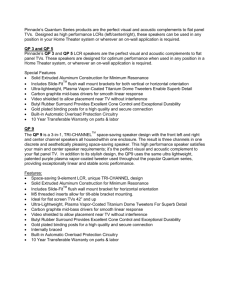

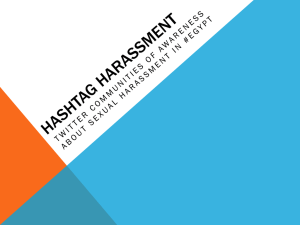
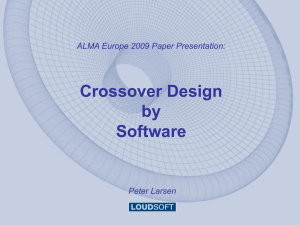
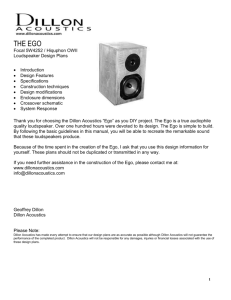
![Triangle Comete 202 Speakers [English] - TNT](http://s3.studylib.net/store/data/007882857_2-fdc24d70463e32ae631516218368b1df-300x300.png)
